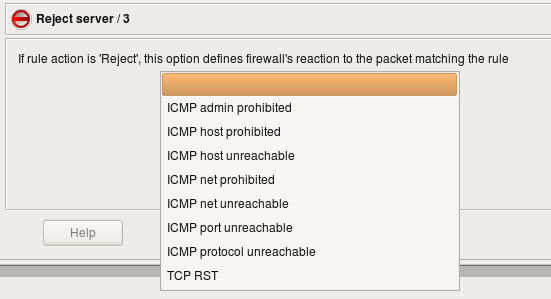Search Users Guide
Suppose we want to block connections to certain ports on the server behind the firewall, but want to do it in a "polite" manner that lets the sender host know right away that the connection attempt was blocked so it appears that our server is not listening on that port at all. One of the practical applications of this setup would be blocking Ident connections to a mail relay or a mail server. Sendmail and many other MTAs (Mail Transport Agents) attempt to connect to Ident port (TCP port 113) on the mail relay every time they accept e-mail from that relay. Many believe that the Ident protocol is practically useless and does not really serve as a protection against SPAM or for any other useful purpose. Unfortunately, silent blocking of Ident connections on the firewall using a rule with action "Deny" adds a delay in the e-mail delivery. This happens because when the sender host tries to establish the Ident connection to the recipient, it sends the TCP SYN packet to it (the first packet in three-way TCP handshake) and then waits for TCP ACK packet in response. However, it never sees it because recipient's firewall blocked its first TCP SYN packet. In situations like this, the sender host assumes the reply packet got lost and tries to send the TCP SYN packet again. It repeats this for a few seconds (usually 30 sec) before it gives up. This adds a 30-second delay to e-mail delivery. Our intent is to show how one can construct a policy rule to block Ident without causing this delay.
The simplest way to block any protocol is to use a "Deny" action in the policy rule. Since "Deny" causes the firewall to silently drop the packet, the sender never knows what happened to it and keeps waiting for response. To avoid this delay we will set rule Action to "Reject". Normally "Reject" makes the firewall to send ICMP "unreachable" message back to sender, thus indicating that access to requested port is denied by the firewall. This may be insufficient in some cases, because the host trying to connect to our Ident port won't understand this type of ICMP message and will keep trying. In fact, most OSs do not recognize an ICMP "administratively prohibited" message and do keep trying. To make the host on the other side stop its attempts right away, we need to send an TCP RST packet back instead of an ICMP message. This can be done by setting the appropriate parameter for the "Reject" action. To set an Action parameter, change the Action to "Reject," then double-click the Reject icon to get the parameters dialog. (see Figure 14.36). It is also safe to turn stateful inspection off on this rule since we do not want connection to be established and therefore do not need to keep track of it.
Supported firewall platforms use different syntax for rules that should drop packets and send an ICMP or TCP RST packet back. Here is what Firewall Builder generates for the rule shown above for iptables:
# Rule 0 (global)
#
$IPTABLES -A FORWARD -p tcp -m tcp -d 192.168.1.100 --dport 113 \
-j REJECT --reject-with tcp-reset
For PF it uses "return-rst" option:
# Rule 0 (global)
#
block return-rst quick inet proto tcp from any to 192.168.1.100 port 113
There is no equivalent configuration option for PIX.
Copyright © 2000-2012 NetCitadel, Inc. All rights reserved.
Using free CSS Templates.


